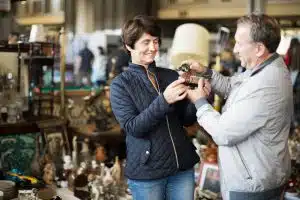 The antique dealer sector has seen a steady increase in popularity in recent years, with many consumers turning to vintage and one-of-a-kind items as a way to add character and personality to their homes. This trend has been driven by a growing interest in sustainable and eco-friendly living, as well as a desire for unique and authentic pieces.
The antique dealer sector has seen a steady increase in popularity in recent years, with many consumers turning to vintage and one-of-a-kind items as a way to add character and personality to their homes. This trend has been driven by a growing interest in sustainable and eco-friendly living, as well as a desire for unique and authentic pieces.
Additionally, the rise of online marketplaces and social media platforms has made it easier for consumers to find and purchase antique items, and for dealers to reach a wider customer base. As a result, many antique dealers have adapted their business models to include online sales in addition to brick-and-mortar storefront
What has been happening in the antiques trade
Antiques are susceptible to recessions or downturns due to their dependence on the economy. As a result of relatively stable economic conditions during the first half of the 2000s, antique dealers benefited. The interiordesign and decor trends of recent years have seen many homeowners opt for modern, minimalist furniture instead of antiques. Throughout the late 2000s and early 2010s, the economy was challenged by a sharp downturn, which made conditions extremely difficult for many.
Investors, collectors, and homeowners were all hit by the downturn in the economy (though the very top end of the market was buoyant).
The industry saw a lot of new antique dealer enterprises launch, so it wasn’t entirely doomed. Some people became interested in hunting for interesting pieces and bargains for the first time after seeing television shows about antiques and collectibles. The antiques trade saw demand begins to firm up again during 2013 as the economy improved. Chinese and Indian collectors are a growing market for some dealers. 2014 and 2015 saw an improvement in the economy, but the second half of 2015 and the first half of 2016 saw a slowdown again.
Since the UK voted to leave the European Union in June 2016, the market has remained fairly lacklustre. Sales to overseas buyers may have been boosted by sterling’s sharp decline and low value into 2018.
Sadly, period furniture fell out of fashion with younger people during the mid 2010s due to a backlash against previously popular television shows. Their taste for minimalist decor and modern furniture is influenced by home improvement shows and interior design magazines. There were substantial drops in the prices of dark mahogany furniture, Victoriana, oak, and country furniture. Prices for period pieces plummeted during the 10 years prior to the mid 2010s, despite reports that prices for mid-20th century furniture had quadrupled.
It is becoming increasingly difficult for dealers to find good quality pieces. Having to travel farther to find them is causing them to spend more time traveling. Private householders have become increasingly knowledgeable about antiques, and instead of selling them to a dealer, they send their own pieces to auction to realise their value. This has contributed to this shortage. This trend has been accelerated by online marketplaces such as eBay and Catawiki.
It is now possible to find buyers and sellers worldwide on eBay, a huge global marketplace. Bric-a-brac and antique dealers have particularly embraced eBay as a way to reduce their costs and reach a much wider audience. Private buyers and sellers are increasingly using eBay, eliminating the need for dealers altogether. eBay isn’t without its downsides for dealers, however. Besides Etsy, there are other online marketplaces that cater to buyers and sellers of retro, vintage, and shabby chic items, such as Sellingantiques.co.uk. Especially for lower-value items, online sales are expected to continue to grow in the future.
In 2006, the UK introduced resale rights for artists which were fully implemented in early 2012. Those who buy and sell artwork over a certain value must pay a levy to the estate or the original artist under the droit de suite laws. Special collecting societies collect the levy. You can get more information about the droit de suite rules by visiting the website of the Design and Artists Copyright Society (DACS). There are also additional costs associated with the rules, as well as more paperwork and administration, so it’s no surprise they aren’t popular.
A ban on ivory sales was announced in April 2018 after years of campaigning by conservationists. In addition to the United States, many other countries either have already introduced ivory bans or plan to do so in the near future.
Keeping up to date with developments
Keep up with industry developments by joining a trade association. An antique dealer’s interests can be represented by a variety of trade associations, which also offer a range of services. Several of them are local or regional, while others are national. A number of local and regional associations are available to dealers, including the British Antique Dealers’ Association (BADA) and the London and Provincial Antique Dealers’ Association (LAPADA).
As the representative body for antique furniture restorers and conservators, the British Antique Furniture Restorers’ Association (BAFRA) represents restoration and conservation professionals. Visit BAFRA’s website to learn more.
Staying up to date can also be accomplished by subscribing to a trade journal. A weekly journal published by the Antiques Trade Gazette includes articles of interest to antique dealers. Collectors, dealers, and specialists can find a wealth of information in Antique Collecting journal, which tracks trends in antique demand.
Read more: Legal issues antique deals will be faced with
Conclusion
A increasing interest in vintage and one-of-a-kind objects has led to a rise in popularity for the UK’s antique dealer industry. In addition to shifting more and more toward sustainable and eco-friendly living, consumers are searching for one-of-a-kind and genuine items to add character and personality to their homes. The growth of social media and online markets has made it simpler for customers to find and buy antiques, and for dealers to reach a larger clientele.
As a result, several antique dealers have seen a trend in the UK of modified their business strategies to include both online and physical storefront sales. It will be interesting to see how the antique dealer sector continues to evolve in the future, and how it will respond to changes in consumer preferences and technology.
Lee Jones is a seasoned Business Finance Specialist with over two decades of invaluable experience in the financial sector. With a keen eye for market trends and a passion for helping businesses thrive, Lee has become a trusted advisor to countless organizations seeking to navigate the complexities of finance.


